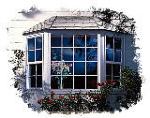Search engine visitors - click here to access entire "$ensible Home" web site
Click here to see a descriptive illustration of several designs of new bow and bay windows.
Dear Jim: I want to give my living room a more open feel, but my budget is limited. I saw some reasonably priced bay windows at a home show. Are they efficient and easy to install? What features should I look for? - Char Z.

A: New complete bay window units are energy efficient and easy to install. They will not only add openness to a room, but actually increase the usable living space. The seatboard can function as a breakfast bar or provide a location for plants that would otherwise take up floor space.
Another similar option is a bow window which consists of four or more glass sections to simulate a rounded appearance. Bay windows have just three sections with the side sections typically angled at 30 or 45 degrees.
Your most economical and easiest-to-install option is a complete bow window unit as opposed to trying to build one yourself from three separate window sections. You remove your current window, enlarge the wall opening to the specified size for your new unit, and nail and screw it in place.
Almost any combination of window types is possible for a bay unit, but a large center picture window with casements on both sides is very popular and the most efficient. The clear vertical casement glass span matches the center picture window and casements provide the best fresh air ventilation.
Bow windows that use maintenance-free vinyl or aluminum-clad wood on the exterior are attractive. The interior surface is either natural wood, that can be painted or stained, or special stainable vinyl. With simulated wood graining, the stained vinyl looks authentic and is also maintenance-free.
Your choices of features is nearly endless. For energy efficiency, choose a bow window unit with rigid foam insulation built into the headboard and seatboard. Some super-efficient ones have foam-filled frames and cavities.
The glass is the heart of any window for efficiency, comfort, glare control and fading resistance. For most climates, low-emissivity (low-e) glass with argon gas in the gap is the minimum to select. Glass with warm-edge technology (insulating spacer separates the glass panes) is also a good choice.
Now with the basics taken care of, your budget will determine other options you may consider. Decorative glass (leaded, frosted, beveled, stained, etc.) can be attractive, particularly in the side sections.
For privacy and glare control, built-in aluminum miniblinds are available. Various types of grids can be used. Snap-on interior grids simulate true divided lites (actual separate small windows), but can be removed for easy cleaning. Motorized windows can be operated with a remote control or automatic rain sensors.
Instant DownloadUpdate Bulletin No. 677 - buyer's guide of 12 manufacturers of the most efficient bay, bow, angle and curved window kits listing frame materials, glass options, colors, warranties and features.
Dear Jim: We use a whole-house fan during the summer to cool our house. It has tight-sealing louvers under it that close snugly. It is necessary to do something else to it during the winter or are the louvers adequate? - Gayle F.
A: Even though the louvers appear to close tightly, most do not produce anything close to an airtight seal. The ceiling is the warmest area in a house and heated air will leak out through it all winter.
Purchase a fan cover. Climb into your attic and place it over the whole-house fan. You can also make one by gluing or taping rigid insulation sheets together. Lay a board on top of the cover for more weight to hold it in place.